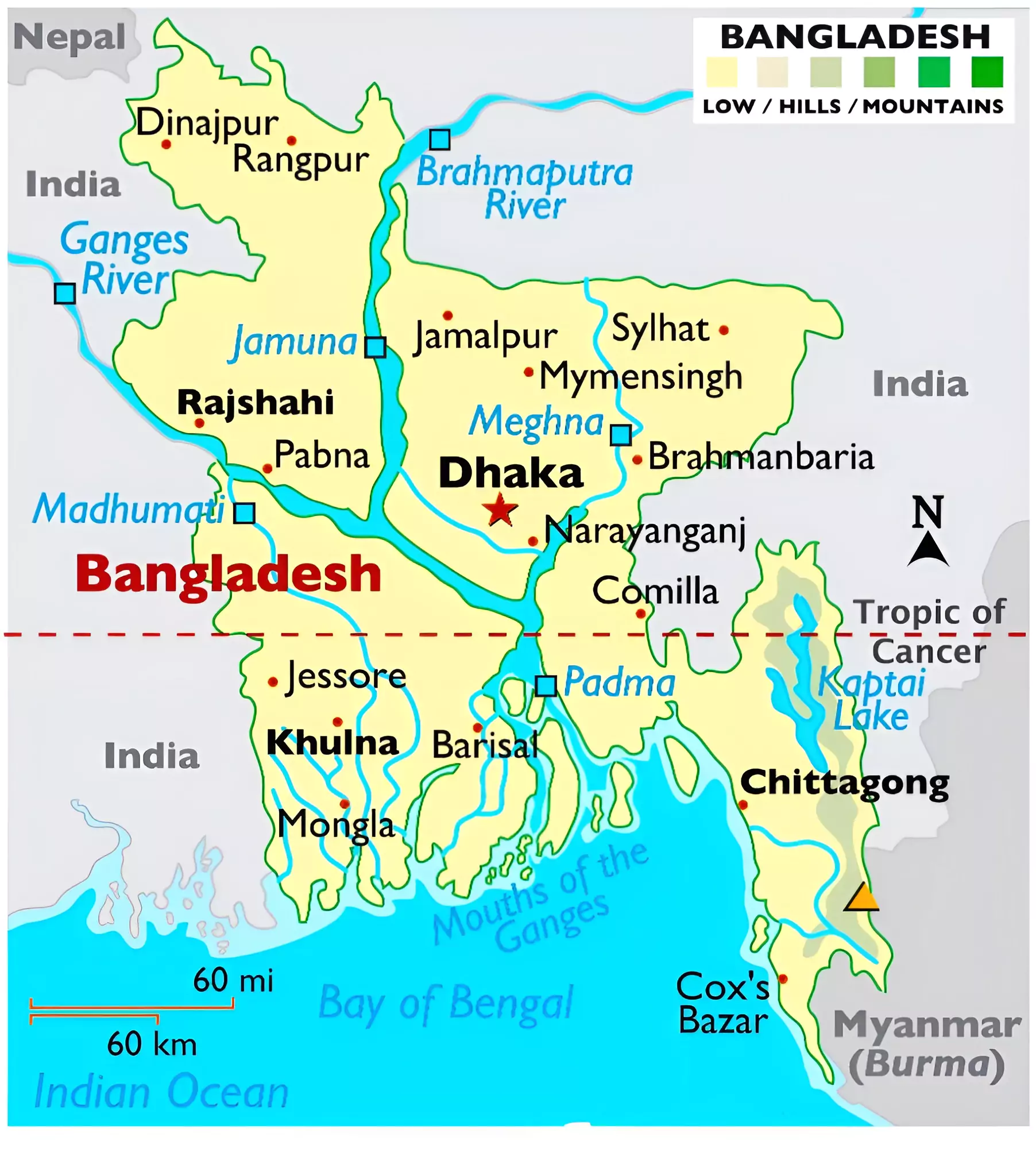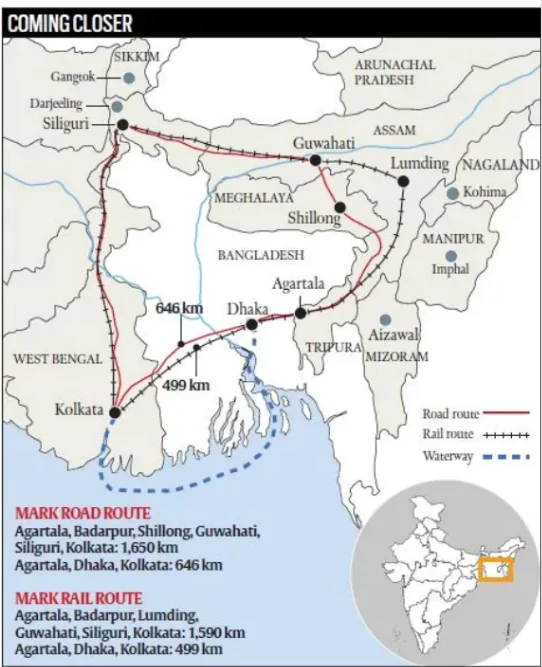Recently, Sheikh Hasina’s resignation as Prime Minister and departure from Bangladesh created multiple uncertainties for India.
- India has been a crucial supporter of Sheikh Hasina, For over one-and-a-half decade she was India’s strongest ally, and during this time, India-Bangladesh relations reached new heights.
Crucial Insights on Bangladesh Crisis 2024
There are multiple factors of the Bangladesh Crisis such as allegations of election rigging, autocratic rule, impact of covid 19 on textile industries, taka depreciation, job scarcity, etc, but the immediate cause is 30% reservation quota.

- Political Discontent: Hasina’s administration has been accused of systematically suppressing opposition voices and dissent. Her long reign in power saw arrests of opposition leaders, crackdowns on freedom of expression and suppression of dissent.
- Critics argue that Hasina’s government undermined democratic processes and institutions. Elections during her tenure were marred by allegations of rigging and violence.
- Human Rights Violations: There have been numerous reports of human rights violations under Hasina’s government, including enforced disappearances and extrajudicial killings.
- Media Censorship: The Hasina administration has faced criticism for curbing press freedom. Journalists and media outlets critical of the government often faced harassment, legal action, or shutdowns.
- Economic Factors: Bangladesh’s economy, although growing, faces issues like unemployment, inflation, and economic disparity. The dissatisfaction among the youth, particularly regarding job opportunities and economic prospects, fueled the unrest.
- About Controversial Quota System:
- Agitation by Students: The protests began in July with students demonstrating against the controversial quota system that allocated government jobs following a High Court order to restore 30% job quotas for descendants of freedom fighters.
- Demand to Struck Down Reservation Quota: Nearly 32 million young people are out of work or education in Bangladesh, which has a population of 170 million. Agitated students called for the 30% reservation quota for the families of freedom fighters to be struck down.
- Violent Protest: The protest turned violent on July 16 as student protesters clashed with security officials and pro-government activists. This led to a curfew with a shoot-on-sight order. The internet and mobile data were also turned off.
- Demand for Resignation: Quota reduced but enraged students demand Sheikh Hasina’s resignation. The protest quickly escalated, spreading civil unrest across the nation.
- Action by Judiciary: To control the protest, the Apex court of Bangladesh scaled back the controversial quota system. The Supreme Court reduced the quota from 30 to 5%, with 93% of jobs to be allocated based on merit.
- Further Degrading of Situation: Adding fuel to the fire, the then PM labelled the protesting students as ‘terrorists’ and urged the people to ‘suppress them with a firm hand’. This led the students to demand the resignation of Hasina and her Cabinet.
- Resignation and Coup: On 5th August 2024, the now ex-PM Sheikh Hasina resigned and fled the country. Thousands of protesters stormed her residence while millions celebrated on the streets.
- Bangladesh’s army chief, General Waker-Uz-Zaman, announced in a broadcast that Sheikh Hasina had resigned and that the military would form an interim government.
Enroll now for UPSC Online Course
Army in Bangladesh Politics
The chequered history of Bangladeshi democracy has seen periodic interventions by the military. The army appointed Chief Justice Abu Sadat Mohammad Sayem as president in November 1975, and the country was ruled by a military junta.
- In 1977, Gen Ziaur Rahman became president; he was assassinated in 1981 and his successor Abdus Sattar was removed in a coup in 1982. Army chief H M Ershad took control, but mass unrest led to his resignation in 1990.
- The civilian governments of Khaleda Zia(1991-96 and 2001-06), and Sheikh Hasina (1996-2001) followed. In between, there was an attempted coup in 1996.
- Following widespread unrest at the end of Khaleda’s term in 2006, the military asked the then president to declare an emergency. A caretaker government was in charge from January 2007 to December 2008.
- After Hasina came back to power in 2008, she made sure that the army returned to the barracks.
- In 2010, the Supreme Court reduced the scope for military interventions through legal loopholes, and reaffirmed the secular principles of the Bangladesh constitution.
|
Significance of Sheikh Hasina’s Tenure to India
The Awami League (AL), led by Prime Minister Sheikh Hasina, has ruled Bangladesh since 2009. From eradicating anti-India terrorist groups which operated out of safe havens in Bangladesh to facilitating greater economic, social, and cultural ties, her tenure has fostered a healthy relationship between India and Bangladesh.
- Acting against Security Threats: It alleviated India’s security challenges along the eastern border of India with proactive measures in tackling terror groups and militancy.
- It acted against ethnic insurgent groups operating from Bangladesh.
- Bangladesh signed an Extradition treaty in 2013 for deporting militants to India.
- It handed over key leaders of the secessionist (United Liberation Front of Asom) to India.
- Significant Strategic Ties: Over the past decade, strategic ties between India and Bangladesh have grown significantly. Bangladesh has been a key beneficiary of India’s “Neighbourhood First” policy, receiving grants and lines of credit to boost energy, financial, and physical connectivity.
- Action against anti-India Militant Groups: Bangladesh shares borders with several Indian northeastern states, many of which have faced militant challenges. Bangladesh cracked down on such activities which operated training camps and transported arms through routes in Bangladeshi territory.
- Land Boundary Agreement: The historic agreement facilitated the transfer of 111 enclaves, from India to Bangladesh. Conversely, India received 51 enclaves which were in Bangladesh.
- Line of Credit: In 2010, during Hasina’s visit to India, India extended $1 billion in credit to Bangladesh under its development assistance programme.
- Ganga Water Treaty: In 1996, both countries signed the Ganga Water Treaty.
- Connectivity to the North Eastern States: Access to India’s northeastern region via Bangladesh diminishes the vulnerability previously associated with connecting to the northeast solely through the Siliguri Corridor, commonly referred to as the Chicken’s Neck region.
- She also granted India transit rights, facilitating the movement of goods from the Indian mainland to its northeastern states.
- Key Achievements in Connectivity: It includes the Maitri Setu bridge over the Feni River in Tripura and the Chilahati-Haldibari rail link.
Check Out UPSC CSE Books From PW Store
Sheikh Hasina’s Ouster and Impact on India
Sheikh Hasina’s departure from Bangladesh after a 17-year-old tenure means that India has lost its strongest ally in the region. Hasina had always been a friend to India. The protests that led to her departure also carried an anti-India sentiment, given the close association perceived between Hasina and India.

- Unclear Nature of Interim Government: Bangladesh army chief Waker-uz-Zaman has taken charge, and so far he has made the right noises in proposing an interim government. But the nature of this interim government remains unclear as yet.
- Nor is there a time-table for fresh elections. The interim government will naturally have a big impact on Bangladesh’s future political direction, which in turn will impact ties with India.
- Also, transit and trans-shipment arrangements with Bangladesh may be revised by the incoming regime in Bangladesh. India needs these for better logistics supply to its Northeast.
- Diplomatic Challenge: India’s strong support for Hasina over the past decade led to minimal interaction with Bangladeshi opposition groups, leaving India in a challenging position now.
- Addressing the current anti-India sentiment in Bangladesh will be difficult.
- Impact on Border Security:
- Jamaat-e-Islami: It is likely that Jamaat-e-Islami may have some influence over the interim government in Bangladesh. India’s equation with Jamaat has been uneasy and it could open the door for the return of Pakistan in Bangladeshi polity. That in turn will have an impact on India’s border security with Bangladesh.
- The China Challenge: China has been aggressively seeking to expand its influence in Bangladesh and has the financial resources to support the post-Hasina government. A strong Chinese presence in Bangladesh poses a significant challenge for India, potentially leaving it:
- Strategically encircled by unfriendly or indifferent neighbours: China and Pakistan to the west and north
- A communist-led government in Nepal
- Taliban-controlled Afghanistan to the far west
- An anti-India Maldives in the Indian Ocean
- A potentially ambivalent regime in Bangladesh
- It would be detrimental to India’s strategic and security considerations.
- Concern over Trade and Free Trade Agreement (FTA): It is unclear if and how an FTA plan would proceed under the interim Bangladeshi government, or the dispensation to follow. The bilateral ties flourished with advances in cross-border trade, transit arrangements, security collaboration, and people-to-people exchanges. However, Hasina’s ouster casts doubt on these achievements.
- Bilateral Trade: According to the Union Ministry of Commerce, in trade terms, Bangladesh is India’s biggest partner in the subcontinent, and India is Bangladesh’s second biggest partner in Asia after China. Their total bilateral trade amounted to $13 billion in the financial year 2023-24.
- Export from India: Bangladesh is the biggest export destination for India’s cotton, accounting for 34.9% of India’s total cotton exports (some $2.4 billion in FY24).
- India’s main exports include vegetables, coffee, tea, spices, sugar, confectionery, refined petroleum oil, chemicals, cotton, iron and steel, and vehicles.
- Import to India: India’s top import from Bangladesh are readymade garments, amounting to $391 million in FY24. In recent years, Bangladesh has emerged as a major global hub for textiles.
- The main import items are fish, plastic, leather, and apparel, among others.
- On Free Trade Agreement (FTA): In October 2023, India and Bangladesh began discussions on an FTA during a meeting of the Joint Working Group on Trade in Dhaka.
- A successful FTA would substantially expand Bangladesh’s market reach and give Indians access to more manufactured goods.
- An FTA would reduce or eliminate customs duties on goods traded and ease norms to help promote further trade and investments.
- A 2012 working paper published by the World Bank estimated that a full FTA for goods would increase Bangladesh’s exports to India by 182%, whereas a partial FTA could lead to a 134% increase.
- An FTA accompanied with improved transport infrastructure and better connectivity could see Bangladesh’s exports rise to 297%. India, too, would see an increase to its exports by as much as 172% in this scenario.
- Impact on Infrastructure and Connectivity: A disruption in Indo-Bangladesh ties could restrict India’s access to the Northeast, which will be connected to mainland India only through the narrow “Chicken’s Neck” — only 22 km at its narrowest — between West Bengal and Assam.
- According to the Minister of External Affairs, infrastructure and connectivity has been a growing part of India-Bangladesh ties. India has extended three lines of credit to Bangladesh since 2016 amounting to $8 billion for the development of road, rail, shipping and port infrastructure.
- In November 2023, two joint projects – the Akhaura-Agartala cross-border rail link and Khulna-Mongla Port rail line – were inaugurated.
- The Akhaura-Agartala link provides an alternate route from mainland India to the Northeast, was the sixth cross-border rail line between the countries. This has cut down the travel time (by train) between Agartala and Kolkata from 31 hours to 10 hours and was expected to boost tourism, trade, and people-to-people exchanges between the two countries.
- Besides rail, there are currently five operational bus routes between India and Bangladesh, including connections from Kolkata, Agartala and Guwahati to Dhaka.
- In 2023, the countries had agreed to operationalise the agreement for the usage of the Chittagong and Mongla ports to ease the movement of cargo between mainland India and the Northeast.
- Return of Islamist Extremism: The ousted Prime Minister represented the secular and modernising version of Bangla nationalism, and her uncompromising politics was for long a bulwark against radical extremism. However, the current scenario has cleared the way for the resurgence of Islamist, anti-Hindu minority, and pro-Pakistan politics in Bangladesh.
Way Forward
Bangladesh is facing its worst political crisis since independence in 1971, with Prime Minister Sheikh Hasina resigning amid massive anti-government protests. While expressing hope for an early resolution to the political instability in Bangladesh, India said that it remains concerned about the status of minorities until law and order is restored.
- Offer Humanitarian Aid: India is prepared to offer humanitarian assistance, including medical aid and supplies, to support Bangladesh during this challenging time.
- Ensure Diplomatic Relations with Interim Government: India needs to move fast to build bridges with the incoming regime. Substantial diplomatic efforts will be required to recover lost ground.
- Similar to India’s stance during Nepal’s 2006 movement, India should respect the popular will in Bangladesh and avoid being perceived as pro-Hasina.
- Transit and trans-shipment arrangements may be revised by the incoming regime in Bangladesh and India needs these for better logistics supply to its Northeast. Hence, India must work with the interim govt to ensure their continuity.
- Trade Adjustments: Indian exporters and businesses are making contingency plans to mitigate the impact of the crisis as the next few days will be critical in determining the extent of the disruption to trade and economic stability.
- A Collaborative Approach: India will need to work with its friends and partners like the US, UK and Europe to limit the violence at the current juncture and work with the Bangladesh Army in ensuring a peaceful transition to a new order within Bangladesh.
- India would want to work with its partners in the Gulf, especially the UAE and Saudi Arabia, to develop pathways for the economic stabilisation of Bangladesh and limit the dangers of extremism.
Enroll now for UPSC Online Classes
Conclusion
In the current evolving situation in Bangladesh, India as a vibrant multi-party democracy, should be seen as supporting the expression of popular will in a sensitive neighbouring country. India will need enormous strategic patience, faith in the logic of geography, belief in the centrality of commerce, and a strong political commitment to transcend the Partition pathologies in building relations with a changing Bangladesh.
![]() 6 Aug 2024
6 Aug 2024



